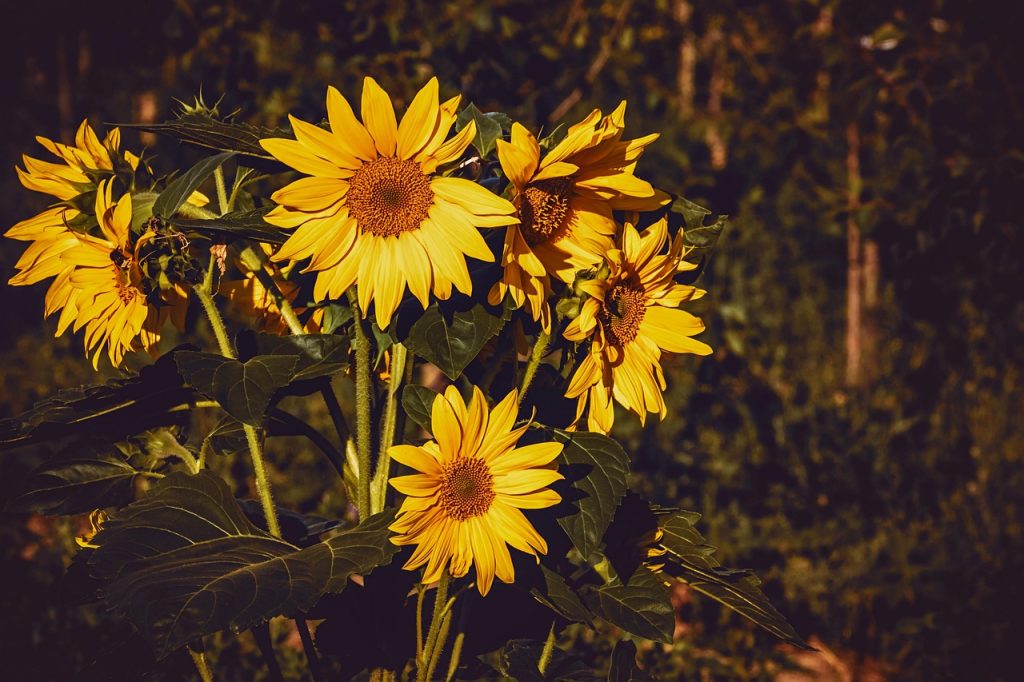Sunflowers, with their towering stalks and bright, cheerful blooms, have long captivated gardeners and nature enthusiasts alike. Their sunny disposition and striking appearance make them a favorite in gardens around the world. Not only do they offer visual delight, but Majestic sunflower are also incredibly beneficial to the ecosystem, attracting pollinators and providing seeds packed with nutritional value.

Background and Origin of Sunflowers
Sunflowers belong to the genus Helianthus, which is derived from the Greek words “helios” (sun) and “anthos” (flower). Native to North America, sunflowers have been cultivated for thousands of years for their seeds and oil. Indigenous peoples of the Americas initially domesticated them, recognizing their potential as a food source and their spiritual significance.
Appearance and Varieties
Sunflowers are easily identifiable by their large, daisy-like flower heads, which can range from vibrant yellow to deep burgundy. They typically grow between 1.5 to 3.5 meters tall, though some varieties can reach towering heights of up to 4.5 meters. The most common Majestic sunflower, Helianthus annuus, features a central disc filled with seeds surrounded by radiant petals.
Popular Varieties
- Mammoth Sunflower: Known for its giant size, this variety can grow up to 3.5 meters tall and is ideal for harvesting seeds.
- Teddy Bear Sunflower: A dwarf variety, perfect for smaller gardens, with fluffy, double blooms.
- Italian White Sunflower: Offers a unique cream-colored bloom with a dark center, adding contrast to your garden.
- Autumn Beauty Sunflower: Features a mix of red, orange, and yellow hues, mimicking the colors of fall.
Ideal Growing Conditions
To cultivate sunflowers successfully, gardeners must replicate their natural environment as closely as possible. These hardy plants thrive in full sun and well-drained soil. Here’s a detailed breakdown of their ideal growing conditions:
Light Requirements
As the name suggests, sunflowers need full sun to flourish. Aim for at least 6 to 8 hours of direct sunlight each day. Planting them in a spot that receives morning sun can help prevent diseases like powdery mildew.
Soil Preferences
Sunflowers prefer loose, well-draining soil with a pH between 6.0 and 7.5. If your soil is clay-heavy or compacted, consider amending it with organic matter to improve drainage and fertility. Majestic Sunflower are not overly fussy about soil quality but benefit from nutrient-rich environments.
Water and Temperature
While sunflowers are drought-tolerant once established, they prefer consistent moisture during their early growth stages. Water deeply but infrequently to encourage deep root development. Aim to keep the soil moist but not waterlogged. Sunflowers thrive in temperatures between 21°C and 29°C.

Planting and Propagation
Planting sunflowers is a straightforward process, but timing and technique can significantly impact their growth. Here’s how to plant and propagate Majestic sunflower effectively:
Seeding Outdoors
The best time to plant sunflower seeds is after the last frost when the soil has warmed to at least 10°C. Sow seeds directly into the ground, spacing them 15 to 30 cm apart, depending on the variety. Plant seeds about 2.5 cm deep and cover lightly with soil.
Propagating Sunflowers
While sunflowers are primarily grown from seed, you can also propagate them through cuttings. Take a cutting from a healthy stem and place it in water or directly in soil. Ensure it receives ample sunlight and moisture to encourage root development.
Seasonal Care and Maintenance
Sunflowers require minimal care once established, but seasonal maintenance can enhance their growth and blooms:
Spring and Summer Care
In the spring, apply a balanced, slow-release fertilizer to support their rapid growth. As Majestic sunflower grow, stake them if needed to provide support, especially in windy areas. During summer, continue to water them deeply, especially during dry spells.
Autumn and Winter Considerations
If you plan to harvest seeds, allow the flower heads to mature on the plant. Cut the heads when the back of the flower turns brown and the seeds are plump. In winter, consider leaving sunflower stalks as they can provide food for birds and other wildlife.

Common Problems and Solutions
While sunflowers are generally resilient, they can encounter a few common problems:
Pests
Aphids, beetles, and caterpillars may target sunflowers. Regularly inspect plants and use insecticidal soap or neem oil as a natural remedy.
Disease
Fungal diseases like powdery mildew and rust can affect sunflowers. Ensure proper spacing for airflow and avoid overhead watering. Remove any affected leaves promptly.
Environmental Stress
Sunflowers can experience wilting or stunted growth if they are stressed by drought or nutrient deficiencies. Ensure consistent watering and consider a soil test to identify any nutrient imbalances.
Real-Life Uses of Sunflowers
Beyond their ornamental value, Majestic sunflower have several practical uses:
Edible Uses
Sunflower seeds are a popular snack, rich in healthy fats, protein, and vitamins. They can be roasted or eaten raw and are often used in baking and cooking.
Oil Production
Sunflower oil is a widely used cooking oil, known for its light flavor and high smoke point. It is also used in cosmetics and skincare products.
Ecological Benefits
Sunflowers attract pollinators like bees and butterflies, promoting biodiversity. They also help remediate contaminated soil by absorbing toxic heavy metals.
Sunflower-Specific FAQs
Plant sunflowers in late spring, after the last frost, when the soil has warmed to at least 10°C.
Depending on the variety, Majestic sunflower can grow anywhere from 1.5 to 4.5 meters tall.
Most sunflowers are annuals, but there are perennial varieties like Helianthus maximiliani that return each year.
Yes, dwarf varieties like the “Teddy Bear” Majestic sunflower can be grown in pots, provided they receive ample sunlight and regular watering.